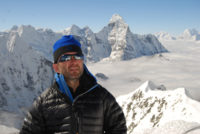When seasoned climber, Mariusz Malkowski began his journey to promote the Z-Wave Alliance of home automation manufacturers on Mount Everest in February, he never imagined the trip would end via a helicopter. Nor did he imagine he would be a survivor of a horrendous 7.8-magnitude earthquake, which hit the Kathmandu Valley, Nepal on April 25, killing more than 7,000 people and injuring more than 10,000.
He had been on the mountain for about three weeks when the avalanche hit.
Malkowski, who works as a technical services manager for Sigma Designs, was on Everest to show how he could control his New Jersey home with a Z-Wave device from the peaks of the highest mountain in the world. “The range of these products is really exceptional. You really can control your home from anywhere — even the top of a mountain range,” he shared.
Malkowski participated in two Z-Wave expeditions before Everest. First was Ama Dablam, a mountain in the Himalaya region of eastern Nepal, and the second was Cho Oyu, located on the border of Tibet and Nepal. From these locations, Malkowski performed live demos of Z-Wave products and operating devices. The Mt. Everest challenge was promoted as the FIBARO Mount Everest Challenge, named for the company who was a lead sponsor. FIBARO is a manufacturer of Z-Wave home automation devices and systems.
The avalanche on Everest occurred just minutes after the deadly quake, killing and injuring climbers. “The ground started to shake and it was way too much for regular glacier movement, this was much stronger. I have been through earthquakes before but not like this – I didn’t know the magnitude but I expected it was a pretty big one,” he said.
Fortunately, his camp was located in northern party of the Everest Base Camp when the avalanche hit, missing the worst of the ice, rocks and snow that covered the base camp below. “The noise was terrible and loud and it was terrifying. The waves of snow and ice were incredible. The group I was with was above the avalanche, so as soon as we could see and realized we were not badly hurt, we rushed to help others.” He and a friend went to the medical tent to help with the triage of those hurt. He saw people with broken limbs, head injuries, and worse, Malkowski recalled.
He stayed for a couple of days to help in the search and rescue on the mountain, then took a helicopter to Katmandu, where he flew home via New Dehli. “It took me less than30 hours from the time I left base camp to get back to New Jersey. It was very surreal, but I am grateful to be reunited with my family; others were not so lucky.”
To date, it has been reported that 19 climbers were killed in the deadly avalanche. Malkowski told SDM that he was able to use a satellite phone to let his family know he was ok. The Z-Wave Alliance was contacted by Malkowski’s family.
Although the FIBARO challenge came to an abrupt and dramatic end, Malkowski wants to return to Mount Everest one day. “The Nepalese people depend on tourism dollars. After this terrible destruction in the country, they will need tourists more than ever. It is important for climbers to go back to Nepal and I will definitely go back one day.”
FIBARO has suggested those who want to help the victims of the earthquake give money through the United Nations Children’s Fund. Visit www.unicefusa.org for more information about how to make a donation to help the vulnerable population that was gravely affected by the earthquake.







